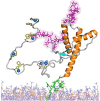The structure of human prions: from biology to structural models-considerations and pitfalls
- PMID: 25333467
- PMCID: PMC4213568
- DOI: 10.3390/v6103875
The structure of human prions: from biology to structural models-considerations and pitfalls
Abstract
Prion diseases are a family of transmissible, progressive, and uniformly fatal neurodegenerative disorders that affect humans and animals. Although cross-species transmissions of prions are usually limited by an apparent “species barrier”, the spread ofa prion disease to humans by ingestion of contaminated food, or via other routes of exposure, indicates that animal prions can pose a significant public health risk. The infectious agent responsible for the transmission of prion diseases is a misfolded conformer of the prion protein, PrPSc, a pathogenic isoform of the host-encoded, cellular prion protein,PrPC. The detailed mechanisms of prion conversion and replication, as well as the high-resolution structure of PrPSc, are unknown. This review will discuss the general background related to prion biology and assess the structural models proposed to date,while highlighting the experimental challenges of elucidating the structure of PrPSc.
Figures



References
Publication types
MeSH terms
Substances
LinkOut - more resources
Full Text Sources
Other Literature Sources

